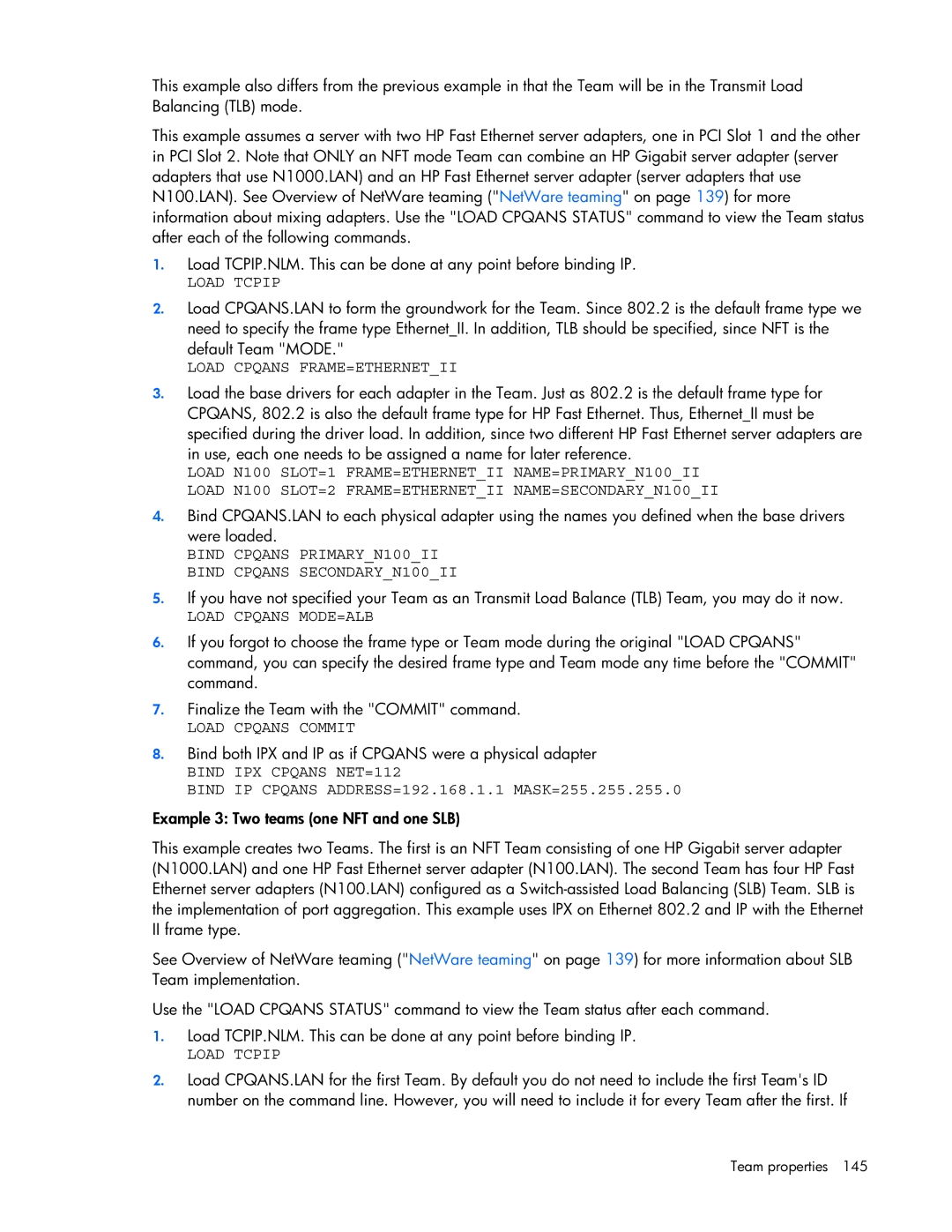This example also differs from the previous example in that the Team will be in the Transmit Load Balancing (TLB) mode.
This example assumes a server with two HP Fast Ethernet server adapters, one in PCI Slot 1 and the other in PCI Slot 2. Note that ONLY an NFT mode Team can combine an HP Gigabit server adapter (server adapters that use N1000.LAN) and an HP Fast Ethernet server adapter (server adapters that use N100.LAN). See Overview of NetWare teaming ("NetWare teaming" on page 139) for more information about mixing adapters. Use the "LOAD CPQANS STATUS" command to view the Team status after each of the following commands.
1.Load TCPIP.NLM. This can be done at any point before binding IP.
LOAD TCPIP
2.Load CPQANS.LAN to form the groundwork for the Team. Since 802.2 is the default frame type we need to specify the frame type Ethernet_II. In addition, TLB should be specified, since NFT is the default Team "MODE."
LOAD CPQANS FRAME=ETHERNET_II
3.Load the base drivers for each adapter in the Team. Just as 802.2 is the default frame type for CPQANS, 802.2 is also the default frame type for HP Fast Ethernet. Thus, Ethernet_II must be specified during the driver load. In addition, since two different HP Fast Ethernet server adapters are in use, each one needs to be assigned a name for later reference.
LOAD N100 SLOT=1 FRAME=ETHERNET_II NAME=PRIMARY_N100_II LOAD N100 SLOT=2 FRAME=ETHERNET_II NAME=SECONDARY_N100_II
4.Bind CPQANS.LAN to each physical adapter using the names you defined when the base drivers were loaded.
BIND CPQANS PRIMARY_N100_II BIND CPQANS SECONDARY_N100_II
5.If you have not specified your Team as an Transmit Load Balance (TLB) Team, you may do it now.
LOAD CPQANS MODE=ALB
6.If you forgot to choose the frame type or Team mode during the original "LOAD CPQANS" command, you can specify the desired frame type and Team mode any time before the "COMMIT" command.
7.Finalize the Team with the "COMMIT" command.
LOAD CPQANS COMMIT
8.Bind both IPX and IP as if CPQANS were a physical adapter
BIND IPX CPQANS NET=112
BIND IP CPQANS ADDRESS=192.168.1.1 MASK=255.255.255.0
Example 3: Two teams (one NFT and one SLB)
This example creates two Teams. The first is an NFT Team consisting of one HP Gigabit server adapter (N1000.LAN) and one HP Fast Ethernet server adapter (N100.LAN). The second Team has four HP Fast Ethernet server adapters (N100.LAN) configured as a
See Overview of NetWare teaming ("NetWare teaming" on page 139) for more information about SLB Team implementation.
Use the "LOAD CPQANS STATUS" command to view the Team status after each command.
1.Load TCPIP.NLM. This can be done at any point before binding IP.
LOAD TCPIP
2.Load CPQANS.LAN for the first Team. By default you do not need to include the first Team's ID number on the command line. However, you will need to include it for every Team after the first. If
